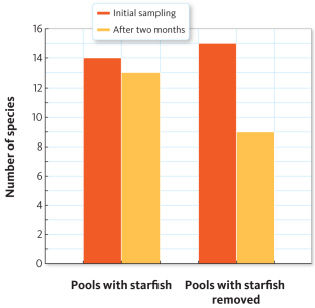Multiple Choice
Robert Paine was the first biologist to use the term keystone species in the 1960s. He was studying food webs in the rocky, intertidal pools in the Pacific Northwest. At one of his study sites, the dominant organisms in the tidal pools were mussels, barnacles, whelks, and a species of starfish known as Pisaster ochraceus . To examine the relationship between these species, Paine set up an experiment. In one area, he removed all the starfish from the tidal pools, and in an adjacent area, he left the tidal pools as he found them. Prior to removing the starfish, he sampled all the organisms in each pool. After two months, he repeated this sampling. A summary of his results is illustrated in the graph below.
Based on these results, would you consider the starfish to be a keystone predator?
A) Yes, because when they are removed, biodiversity declines.
B) No, because when they are removed, biodiversity declines.
C) Yes, their presence results in higher levels of predation.
D) No, they have little or no impact on the other organisms.
Correct Answer:

Verified
Correct Answer:
Verified
Q19: A beetle that feeds on the leaves
Q20: If you own a dog, each year,
Q21: Among Madagascar hissing cockroaches, males have horns
Q22: A researcher surveys the number of salamanders
Q23: A beetle that feeds on the leaves
Q25: Susan is studying tree growth in two
Q26: Spiders are predators that will eat just
Q27: Robert Paine was the first biologist to
Q28: Interspecific competition includes all of the following
Q29: The image below represents the termites, bacteria,